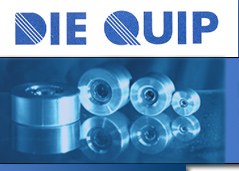|
It is highly
recommended that
all rough cord dies
be made using the
meeting point method
to provide the correct
bearing length to
start the dies life.
This makes it easier
to bump the die
to the next size
when it is worn
and maintain its
correct bearing
length. It is also
strongly recommended
that the die be
ground and then
polished to ensure
the angle is made
to a true conical
shape and is concentric
to the outside diameter
of the die case.
Since rough cords
have inherently
inaccurate geometry,
do to their manufacturing
process, just polishing
the approach angle
can result in eccentric
bearing lengths.
To cut a used
die to a meeting
point requires the
bearing to be removed
and taken to the
desired meeting
point size as shown
in figure 2.
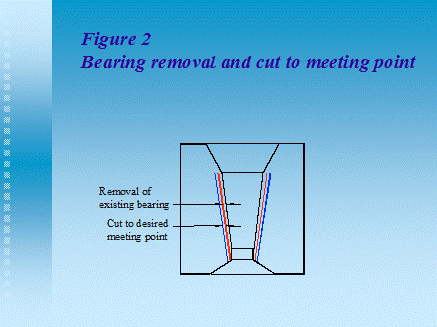
This requires
removing a large
amount of material
from the die but
is the only way
to produce an accurate
bearing length.
For example to make
a .150” (3.80mm)
12 degree 50% bearing
length die, it has
a meeting point
of .136” (3.45mm)
which means a jump
in size of .014”
(0.35mm). The draw
back is any sizes
that could be used
between the finished
size you are looking
for and the meeting
point are skipped
and the die will
loose a number of
potential recuts.
The practical problem
with cutting a used
die to a meeting
point is estimating
how much will it
take to remove the
bearing since grinding
on the angle is
not a 1:1 relationship.
This is due to the
fact you are cutting
into the angle not
on the diameter
as show in figure
3.
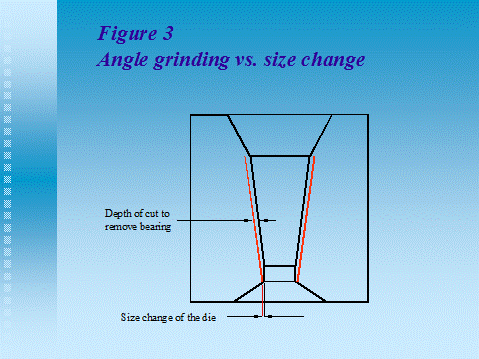
Bumping Method
The other method
to make dies is
to take them from
one size to the
next closest size
needed which I refer
to as bumping.
This can be done
in rough cord dies
that are purchased
with a preformed
bearing or more
commonly with used
dies.
Bumping advantage
over the meeting
point method is
speed and number
of reworks. A die
can be bumped in
a matter of 2-4
minutes if you are
only taking .002-.003”
(0.05-0.08mm).
Unfortunately, as
the bumping amount
and bearing length
grows the time increases
quickly. To bump
a die .010” (0.25mm)
it will take as
long as using the
meeting point method.
Rough Cord
To bump a rough
cord it must have
a preformed bearing
to the correct length.
In the US only R7
and larger dies
are supplied with
a preformed bearing
length which is
typically 35%.
Purchasing R6 and
smaller with a preformed
bearing or a different
bearing length other
than 35% can be
done but will increase
the cost and lead-time
of the rough cord
significantly.
In Europe many rough
cords are typically
produced with a
preformed bearing
length of 35%.
This leaves other
lengths to large
quantity orders
or an increased
cost along with
longer lead-times.
Bumping a die
from rough cord
or used size to
a new size is very
simple. All you
need to do is calculate
the difference between
the starting size
and the desired
size to determine
the amount to remove.
The largest problem
is if the bearing
is increased in
size without removing
material from the
approach angle the
bearing length will
grow from the starting
length as shown
in figure 4.
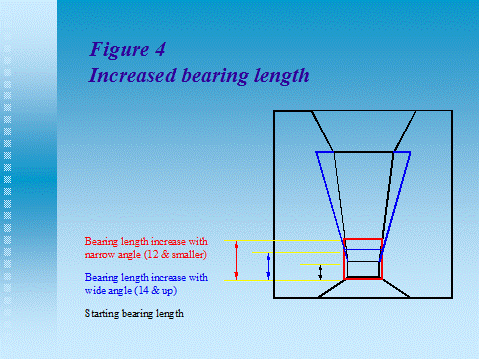
For this reason
any time the die
is increased in
size it must be
worked on the angle
to prevent the bearing
from getting too
long. The problem
becomes how to determine
the amount of material
to remove from the
angle to return
the bearing to the
correct length.
The other problem
is there is no way
to verify this on
the die finishing
equipment especially
in a polishing cycle
which means the
die needs to be
removed from the
machine, cleaned
and inspected.
If the bearing length
is still too long
it must be returned
to the machine for
additional material
to be removed from
the angle. If the
length is too short
the die must be
remade or more commonly
it is sent into
production which
results in a shorter
production life.
For example if you
only bump a die
.004” (0.10mm) there
is not enough material
to grind and polish
the angle. If you
only use diamond
compound and time
the question is
how much time do
you set on the machine
to remove .004”
(0.10mm) from the
angle and with what
compound grade?
This still hasn’t
determined if the
.004” (0.10mm) is
the correct amount
to remove to keep
the correct bearing
length which would
have to be done
with a geometric
calculation using
the approach angle,
increase in diameter,
back angle and bearing
length.
The other major
problem with bumping
dies is if you do
not want a 35% bearing
length as preformed
into the rough cord
die how do you change
it? To make a longer
length you will
need to start with
a smaller diameter
and cut the bearing
to size first causing
it to grow in length,
then the length
will need measured
to determine how
much to grind from
the angle to get
it to the desired
length. On the
other hand if you
want a shorter length
you will need to
calculate how much
additionally to
remove from the
angle to cut the
bearing to the shorter
length. None of
this geometry is
overly difficult
to calculate but
it is time consuming.
In most shops
the die personnel
do this visually
instead of using
geometry and determine
what to do from
their experience.
The problem is our
eyes do not have
a measuring capability,
which typically
leads to bearing
lengths that are
too long. Physical
tracing machines
work very well to
measure the bearing
length but this
requires the die
to be removed from
the machine, measured,
calculated and returned
to the machine for
additional work.
This increases the
working cycle and
requires the investment
into an expensive
tracing unit.
Used Dies
Bumping worn
dies has all of
the same issues
as discussed with
rough cord dies
in regards to bearing
length along with
a few additional
concerns. If you
are only moving
a die a couple thousands
of an inch or hundredths
of a millimeter
to the next size
it is critical that
the wear ring/drawing
marks are completely
removed from the
bearing and approach
angle. This must
be done by removing
an entire plane
of material from
both the bearing
and approach angle
as shown in figure5.
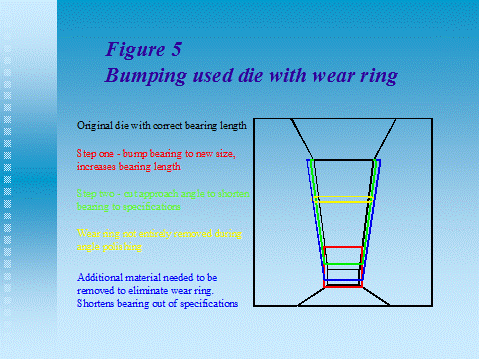
Typically, this
requires more material
to be removed than
the amount to take
it to the next size,
which is why many
die makers bump
finished dies instead
of, used. In bumping
a used die, die
makers often do
one of two things
in this instance.
First, they polish
the angle by hand
to blend out the
wear, which leaves
very poor die geometry
that will cause
it to fail prematurely.
The other common
method is to remove
an entire plane
of material until
the wear is gone
in the angle which
shortens the bearing
length to an unknown
percentage which
will shorten the
dies production
life by growing
oversize too quickly.
Since dies typically
wear more on one
side it is important
to visually inspect
bumped dies to make
sure the entire
wear ring has been
removed. Also if
the wire is pulled
out of the die on
an angle it will
cause the die to
be oval which might
not be removed by
bumping and can
be difficult to
see in a visual
inspection resulting
in out of round
wire.
How to Choose
With all of these
items to consider
how do you choose
the best method
to use? First,
all new rough cord
dies should be cut
to a meeting point
to ensure the correct
bearing length so
if the die is bumped
a reasonable bearing
length can be maintained.
If dies are purchased
finished bearing
lengths should have
a tolerance and
be inspected prior
to use. The main
consideration is
what material is
being drawn and
how much tolerance
in the bearing length
can be allowed.
Since the bearing
length creates frictional
heat shorter bearing
lengths reduce heat
generation but will
increase the chance
the die will wear
oversize prematurely.
On the other hand
too long of a bearing
length increases
the heat in the
bearing typically
causing lubrication
failure that results
in metal pickup.
To ensure correct
bearing lengths
the only method
to use is the meting
point. It shortens
the number of potential
uses of the die
but provides a consistent
die that does not
need to be inspected
for its length.
Making dies to meeting
points takes more
time in the die
shop than bumping.
For hard to draw
materials and applications
that require tough
material specifications
it is critical to
make dies to the
meeting point to
control bearing
lengths.
Bumping dies
is a quick way to
make dies but with
out proper supervision
or measuring equipment
it normally leads
to inconsistent
bearing lengths.
If used properly
it is an effective
die making tool
that increase the
production of the
die shop where bearing
lengths do not need
to be held to a
tight tolerance.
In conclusion
to produce consistent
high quality wire
it requires consistent
die geometry. An
accurate approach
angle, correct size
and bearing length
all effect the production
life of the die
along with the mills
efficiency. Using
the meeting point
eliminates one of
these variables,
which is why I strongly
recommend their
use. It may take
slightly longer
to make dies this
way but the payoff
in consistent production
results payback
significantly.
Bumping can be used
effectively but
most cases it results
in a varying bearing
length in all the
dies and lower production
efficiency unless
the dies are constantly
inspected with the
die ship personnel
properly trained.
|
